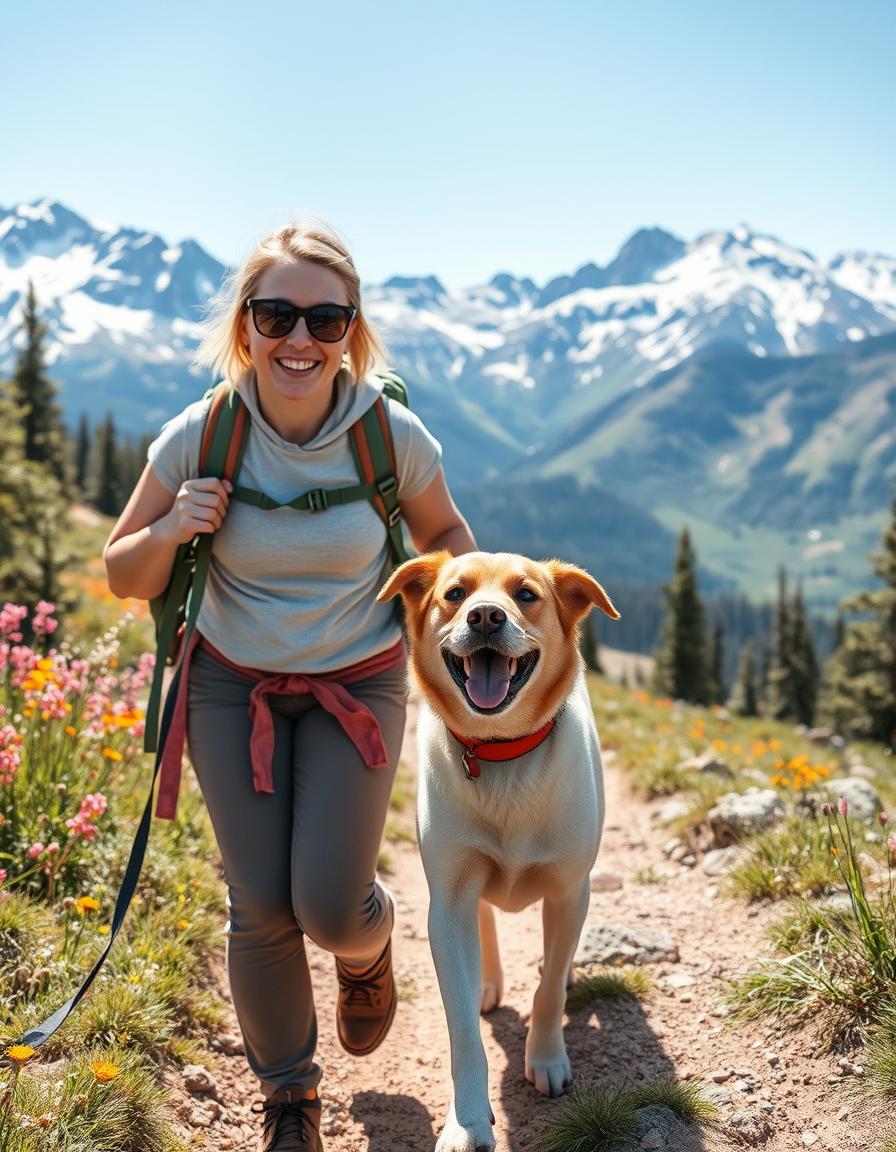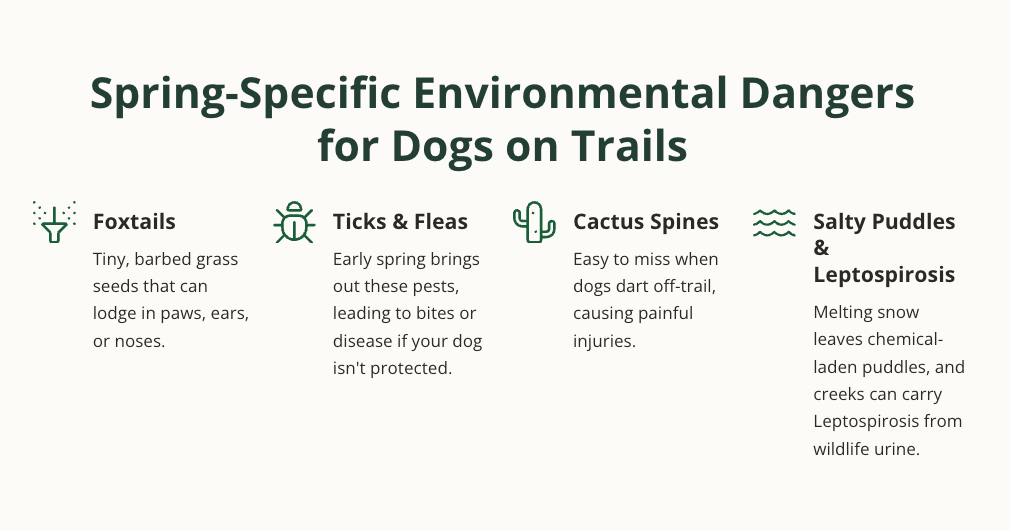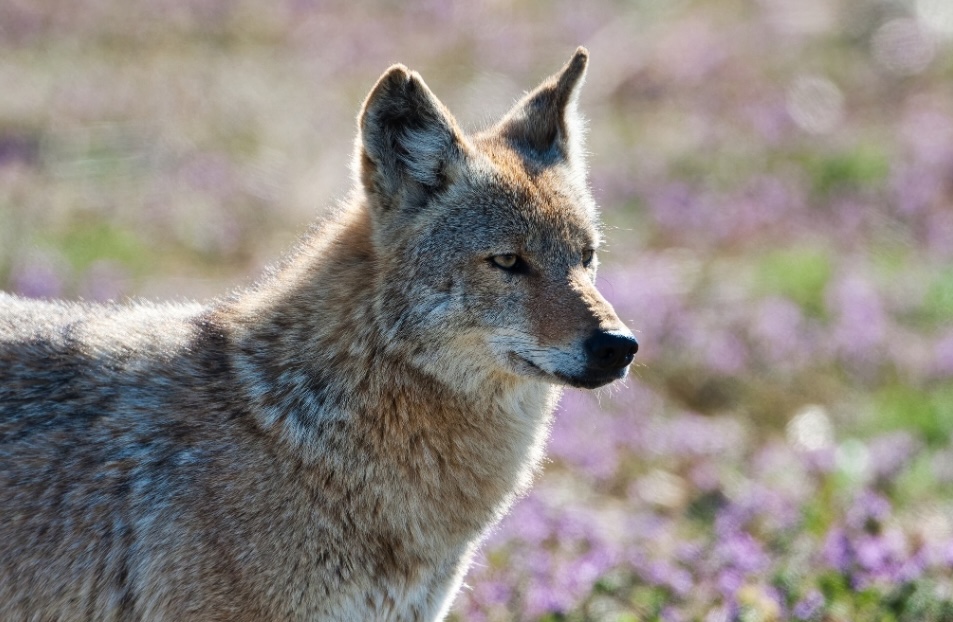Spring in Colorado is a beautiful time to hit the trails with your dog. The snow is melting, the air feels fresh, and wildflowers start to bloom. It’s the season of new adventures—for both you and your four-legged friend.
But spring hiking isn’t as simple as it seems. Trails can turn slippery with leftover ice or mud. Wild animals come out more often. And hidden dangers like ticks and fleas, foxtails, and [salty puddles] can catch you off guard.
Keeping dogs safe on the trails in the spring means planning ahead. You’ll need to think about gear, the weather, and how ready your dog is after a long winter. This guide will walk you through it all so you can enjoy the trails with confidence—and keep your dog healthy and happy the whole season.
Spring-Specific Environmental Dangers for Dogs on Trails
Spring trails might look safe, but hidden dangers are everywhere. Foxtails—tiny, barbed grass seeds—can lodge in your dog’s nose, ears, or paws. Even though they peak in late summer, some grassy areas in early spring still carry the risk.
ticks and fleas also come out early. If your dog isn’t protected, a short walk can lead to itchy bites or even disease. Then there’s cactus spines, which are easy to miss when your dog darts off trail.
Another problem is water. Melting snow can leave behind salty puddles full of de-icing chemicals. Drinking from them can upset your dog’s stomach or worse. Even flowing creeks can be unsafe—Leptospirosis, spread by wildlife urine, lives in spring water and causes serious illness.
Don’t forget the ground beneath your dog’s paws. At just 70°F, sun-warmed pavement can burn. Sharp rocks and broken branches are more exposed as snow melts, so even natural trails can cut or bruise sensitive paws.
How Weather and Trail Conditions Affect Dog Safety in Spring
One moment it’s sunny, the next it’s snowing. In Colorado, spring weather is wild and fast-changing. On a single hike, you could deal with sunburn, slush, and hail—all within an hour.
This means trail conditions can shift fast. Muddy slopes turn slippery. Ice patches hide under shady trees. What starts as a dry walk might end with your boots sinking in slush. If your dog isn’t ready for that, it could lead to slips, sore muscles, or cold stress.
To stay safe, bring gear that fits spring’s mood swings. A towel, lightweight jacket, and paw protection go a long way. Think ahead—keeping dogs safe on the trails in the spring means expecting the unexpected.
What to Expect from Colorado Wildlife During Spring Hikes
Coyotes, deer, and mountain lions are more active—know when and where to avoid them.
Spring is one of the most active seasons for wildlife in Colorado. [Coyotes, mountain lions, foxes, and deer] are all more visible as they search for food, mates, or shelter. Your dog’s natural curiosity or instinct to chase can put them—and you—in danger.
To reduce the risk of a surprise encounter, try to avoid hikes at dawn or dusk. These are the busiest hours for wildlife movement. Stick to well-trafficked trails where animals are less likely to appear. And always be alert—watch for fresh tracks, scat, or rustling in brush.
Even if you’ve hiked a trail dozens of times, spring brings change. What was once safe may now be part of an animal’s territory.
Why Leash Control and Voice & Sight Training Are Critical
One of the best ways to protect your dog from wildlife is with a leash or strong voice control. Boulder’s Voice & Sight Control (V&S) Program allows trained dogs to hike off-leash on approved trails—if they wear the V&S tag and respond immediately to commands.
If your dog doesn’t have a reliable recall or gets easily distracted, keep them leashed. Even a friendly dog can spook wildlife or chase into danger. Plus, many trails require leashes by law—ignoring that can result in fines or worse.
Remember, 1 in 3 dogs go missing during their lives. A moment of distraction on the trail could lead to heartbreak.
Using a leash isn’t just about control—it’s about care. Whether you’re exploring new ground or a local favorite, keeping your dog safe on the trails in the spring starts with smart leash habits.
Responsible Hiking with Dogs: Trail Etiquette and Environmental Care
 How to Practice Good Trail Etiquette with Your Dog
How to Practice Good Trail Etiquette with Your Dog
Yielding, packing out waste, and respecting leash zones make hiking safer for all.
Being a thoughtful hiker isn’t just polite—it keeps everyone safe. When you’re on a narrow path, yield to other hikers by stepping aside and keeping your dog close. Not every dog wants to say hi, and not every person is comfortable around pets.
Always pack out your dog’s waste. Leaving it behind can harm local ecosystems and frustrate fellow hikers. Bring extra bags and a sealed container if needed.
Most trails in Colorado have clear leash zones and rules. These aren’t just suggestions—they help prevent accidents and protect wildlife. Staying informed and respectful shows you’re a responsible trail user.
Applying Leave No Trace Principles When Hiking with Dogs
Stay on trail and reduce wildlife impact to hike responsibly with your pet.
[Staying on marked trails] helps protect fragile plants and nesting animals. Letting your dog wander off path might seem harmless, but it can disrupt habitats and increase erosion.
Try to minimize your dog’s interaction with wildlife. Chasing birds, squirrels, or deer not only stresses animals—it could also put your dog at risk. Keeping dogs safe on the trails in the spring means protecting nature as much as we protect them.
Teaching your dog to be calm and focused helps make you a more welcome part of the hiking community.
Packing Checklist for Safe and Comfortable Dog Hikes in Spring
Don’t hit the trail without these must-have dog safety items.
- Rubberized leash for better grip in muddy terrain
- Dog boots or paw balm to protect against ice, heat, and sharp ground
- Dog-safe insect repellent to keep ticks and fleas away
- Lightweight jacket for cold winds (especially for short-haired dogs)
- Towel and paw washer for muddy paws before the car ride home
- Collapsible water bowl and fresh water to prevent dehydration
- High-protein treats for energy on longer hikes
- Dog first aid kit with basics like tweezers, bandages, and antiseptic wipes
A little prep goes a long way in making your hike smoother and safer—for both you and your trail-loving dog.
How do I keep my dog safe while hiking in the spring?
To keep your dog safe while hiking in the spring, start with leash control, trail etiquette, and the right gear. Be aware of changing weather, avoid wildlife-active hours, and always carry water and first-aid supplies. Begin with short, low-risk hikes to help your dog rebuild stamina after winter.
Spring hiking in Colorado is full of joy—but it also brings new challenges. From melting snow and salty puddles to coyotes and fast-changing weather, each trail holds its own surprises. Planning ahead keeps you ready for anything.
If you’re looking for extra support this season, Off Road Paws offers expert-led fitness adventures and pet care tailored to Colorado’s unpredictable trails. With veterinary-informed services, personalized routines, and a deep love for dogs, we make sure your pet is safe, happy, and healthy—on every hike.
Whether your dog needs a reconditioning run, a wellness walk, or just some off-leash joy with supervision, we’re here to help them thrive outdoors. Because adventure is better when your best friend is protected every step of the way.
Happy trails—and safe exploring from Off Road Paws.


